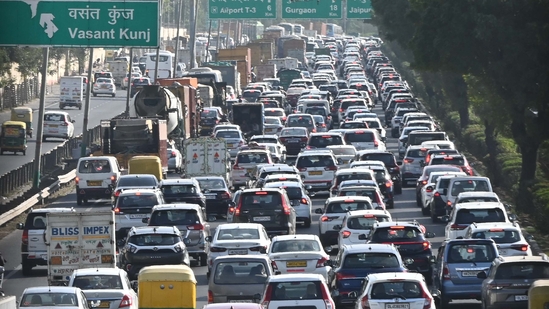Outer Ring Road buckles under daily congestion, design flaws

On paper, Delhi’s 47-kilometre-long Outer Ring Road is a major arterial route designed to streamline urban mobility, connecting sprawling residential pockets to the city’s economic and administrative centres. In practice, it has become a congested corridor of frustration—plagued by poor design, ill-placed signage, chaotic merging, and an alarmingly high number of road crashes.

Its size should be an advantage. But infrastructure on the stretch has failed to evolve with the capital’s rising traffic load. According to traffic engineering experts, the problem lies less in space constraints and more in the absence of fundamental safety and design interventions.
S Velmurugan, chief scientist and head of the traffic engineering division at the Central Road Research Institute (CRRI), accompanied HT on a visit to key congestion points. His verdict: “The road has reached its carrying capacity, but small, systemic fixes could still make a big difference.”
A loop too tight: Modi Mill flyover, 3pm
At 3pm, traffic at the Modi Mill flyover bore all the signs of design-induced stress. Two fast-moving traffic streams merge on the top deck—without an auxiliary lane for acceleration or deceleration. Poor signage and the absence of a speed table for pedestrian crossing further compound the risk.
“The downward loop has two successive left turns, but signage is placed too low and lacks retro-reflective visibility,” Velmurugan said. He recommended triple chevron markings, gore area treatments using plastic bollards, and solar studs to demarcate ramps. A bus stop placed just beyond the loop exit causes bottlenecks within seconds.
Choke point: Kalkaji to Savitri Flyover, 3.30pm
Just minutes away, the stretch between Kalkaji and Savitri flyovers narrows abruptly near a temple, shrinking from four lanes to two. Devotees often stop nearby, creating another unregulated obstacle.
“The single-direction Savitri flyover is outdated for the volume it carries. Plans for doubling it have been pending for years,” Velmurugan said. He also flagged misplaced signs, substandard noise barriers, and the continued use of unsafe steel girders—discouraged by Indian Roads Congress (IRC) guidelines.
One rare bright spot: a well-marked lay-by near Kalkaji flyover, maintained by Delhi Metro, where cabs and autos can stop without obstructing traffic.
Dangerous design: IIT Flyover, 3.47pm
The IIT flyover begins with what looks like a concrete hump—poorly marked and dangerous. “Speeding vehicles can easily go airborne,” said Velmurugan, calling it a textbook case for gore area treatment.
Gore areas—the triangular zones where roads split or merge—should be clearly marked with diagonal stripes, solar blinkers, and soft cones. “These low-cost interventions improve safety dramatically,” he said.
Confusion zone: Mukundpur intersection, 4.31pm
At Mukundpur, drivers—HT reporters included—slowed or stopped to figure out where to turn. A former roundabout has been partially closed, replaced by a U-turn too tight for buses. Just before the turn, a loop towards ISBT is preceded by a cluttered sign with too much text to read at speed. Further ahead, old roundabout signage remains, even though it no longer exists.
“This is not a space issue, it’s a will issue,” said Velmurugan. “We had a chance to redesign the U-turn and signage, but it wasn’t done.” As he spoke, a bus struggled—and failed—to take the turn cleanly.
Volume overload: Mukarba Chowk, 4.55pm
By 4.55pm, traffic at Mukarba Chowk had swelled to a crawl. Lanes drop from five to three at the flyover, while a mix of private cars, light commercial vans, and long-haul trucks fight for space en route to Haryana.
To make matters worse, two signs pointing to the same turn use different labels—‘Karnal’ on one, ‘Singhu Border’ on another.
“This is a key connector to NH-1,” Velmurugan explained. “Entry of commercial vehicles, especially the growing number of light commercial vans, forms a large chunk of traffic.”
A road of crashes
Data from Delhi Traffic Police paints a grim picture. In 2022, the Outer Ring Road recorded 349 crashes—up from 280 in 2021. The northern section, especially between Azadpur and Dhaula Kuan, saw the most incidents. While the number dipped slightly to 326 in 2023, the road remains Delhi’s most crash-prone corridor.
A citywide survey last year flagged 134 congestion hotspots—12 of them along the Outer and Inner Ring Roads.
The way forward
Velmurugan insists the fixes aren’t revolutionary—just long overdue. “Signage that meets height and visibility standards, proper lane markings with plastic paint, glare-resistant barriers in flyover medians, and improved ramp geometries can change driver behaviour,” he said.
But he added a note of caution: these improvements must go hand in hand with a shift to public transport. “Delhi’s roads can’t carry more. Unless we expand and prioritise public and informal transport, the traffic crisis will keep returning—loop after loop.”















